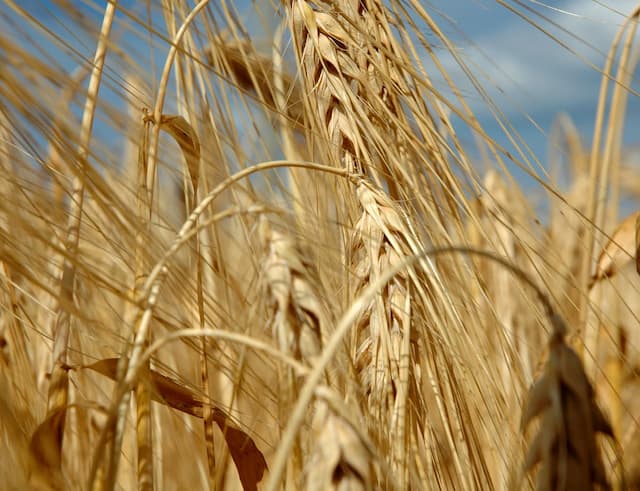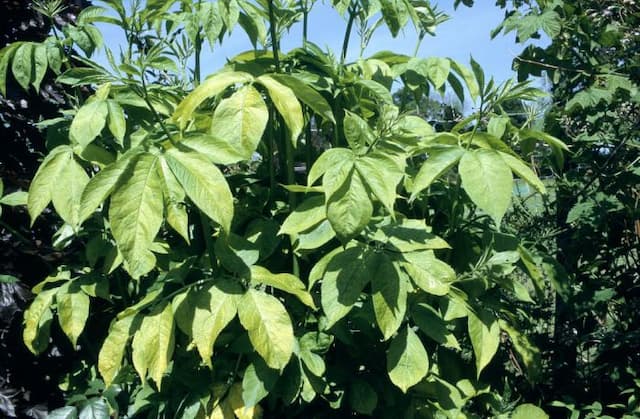Elder Sambucus nigra



ABOUT
Sambucus nigra, also known as the Black elderberry, is a deciduous shrub or small tree that can grow up to 12 feet tall. It has a round, open crown and a slightly irregular shape. The bark is smooth and gray-brown in color, while the branches have a slightly zigzag shape.
The leaves of Sambucus nigra are opposite, pinnately compound, and have 5-9 leaflets. The leaflets are ovate to elliptical in shape, and have serrated edges. They are dark green in color and have a smooth texture.
The flowers of Sambucus nigra are small, white and borne in large, flat-topped clusters that are 5-8 inches across. They bloom in late spring to early summer.
The fruit of Sambucus nigra is a small, round, black berry that is about 1/3 inch in diameter. They are usually ripe and edible in late summer to early fall.
Overall, Sambucus nigra is a striking plant, with its dark green leaves and large clusters of white flowers, followed by dark berries.
About this plant
 Names
NamesFamily
Adoxaceae
Synonyms
Elder, Elderberry, Black elder, European elder, Common elder, Acte, Arn tree, Black elderberry, Boon tree, Boor tree, Bore tree, Bour tree, Bur tree, European elderberry, Pipe tree, Tramman
Common names
Sambucus nigra
 Toxicity
ToxicityTo humans
Elder is generally considered safe for human consumption.
However, the unripe berries, leaves, and bark of the plant contain a toxin called sambunigrin, which can cause stomach upset if eaten in large quantities. Therefore, it is recommended to only consume the ripe berries and not the other parts of the plant.To pets
Sambucus nigra is toxic to animals, particularly livestock.
The unripe berries, leaves, and bark of the plant contain a toxin called sambunigrin, which can cause gastrointestinal upset and even death if ingested in large quantities. Therefore, it is not recommended to give animals any part of the plant for consumption.
 Characteristics
CharacteristicsLife cycle
Perennials
Foliage type
Deciduous
Color of leaves
Green and yellow in the fall
Flower color
White
Height
Up to 12 feet
Spread
Up to 12 feet
Plant type
Shrub
Hardiness zones
3
Native area
Europe, northern Africa and western Asia
Benefits
 General Benefits
General BenefitsThe high levels of vitamin C and other antioxidants in Sambucus nigra can help to boost the immune system, making it more effective at fighting off infections and illnesses;
The compounds in Sambucus nigra have anti-inflammatory properties, which can help to reduce inflammation in the body and alleviate conditions such as arthritis and asthma;
The berries of Sambucus nigra are edible and can be used in a variety of culinary applications, such as jams, syrups, and pies;
Sambucus nigra is a ornamental plant, it's large clusters of white flowers and dark berries make it an attractive addition to any garden. Medical Properties
Medical PropertiesThe compounds in Sambucus nigra have been shown to have anti-viral properties, which can help to reduce the symptoms of viral infections such as the flu and the common cold;
The compounds in Sambucus nigra have anti-inflammatory properties, which can help to reduce inflammation in the body and alleviate conditions such as arthritis and asthma;
Sambucus nigra has been shown to have a beneficial effect on heart health, by reducing cholesterol levels and blood pressure;
Sambucus nigra is rich in antioxidants, it can be used as a supplement to boost antioxidant levels in the body. Other Uses
Other UsesThe berries of the plant are edible and are often used to make jams, jellies, syrups, and wine. They can also be dried and used in teas, pies, and other baked goods;
Elderberry has been used for centuries in traditional medicine to treat a variety of ailments, including colds, flu, and fever. It is also used as a diuretic, laxative, and to treat skin conditions;
Elderberry extract is often used in beauty products such as soaps, lotions, and hair care products due to its antioxidant properties;
The plant can be used as a natural dye for fabrics and yarns;
Elder can be used as a natural pest control measure in gardens;
Flowers of the plant is used to make elderflower cordial, a popular non-alcoholic drink in Europe.
Interesting Facts
 Plant Symbolism
Plant SymbolismIn the folklore, it is believed to have protective properties and was often planted near homes to ward off evil spirits;
It was also believed to bring good luck and prosperity;
In some cultures, it symbolizes rebirth and renewal because it is one of the first plants to leaf out in the spring;
In others, it is considered a symbol of wisdom, as it was believed that the elder tree was home to the spirit of an elder who would bestow wisdom upon those who asked.
 Water
WaterIt prefers well-drained soil and should not be overwatered.
Watering once a week should be sufficient, but be sure to check the soil moisture level and adjust watering as needed. Light
LightSambucus nigra can tolerate full sun to partial shade, but it will produce more fruit when grown in full sun.
 Temperature
TemperatureIt is hardy in USDA plant hardiness zones 4 and higher and can tolerate temperatures as low as -30°F. It can survive in a wide range of temperature and humidity.
 Pruning
PruningTo prune Sambucus nigra, you can start by removing any dead, diseased, or damaged wood. This can be done at any time of the year. Then, in the late winter or early spring, prune back the previous year's growth by about one-third to promote bushier growth and larger blooms. Avoid cutting back into old wood, as this can inhibit the plant's growth. Also, be sure to wear gloves as the plant's bark and leaves can cause alergic reaction.
 Soil
SoilSambucus nigra, also known as elderberry, prefers well-drained soil that is rich in organic matter.
A soil pH between 6.0 and 7.0 is ideal. The plant can tolerate a range of soil types, but it prefers a slightly acid to neutral soil.
Adding compost or well-rotted manure to the soil can help to improve its fertility and drainage. Repotting
RepottingElderberry plants do not need to be repotted frequently, as they are relatively slow-growing. A container-grown plant may need to be repotted every 2-3 years, or when the roots have become pot-bound.
 Humidity & Misting
Humidity & MistingElderberry plants prefer a slightly humid environment. They tolerate a wide range of humidity levels, but they will perform best when humidity levels are between 40 and 60%.
If the air in your home is particularly dry, you may need to mist the foliage occasionally to maintain the optimal humidity level for the plant. Suitable locations
Suitable locationsIndoor
Sambucus nigra is a deciduous shrub that typically grows outdoors.
It can be grown indoors as a container plant, but it can be challenging to provide the necessary light and temperature conditions for it to thrive.
When growing Sambucus nigra indoors, it is important to provide it with bright, indirect light and to keep the soil consistently moist but not waterlogged. It prefers cool temperatures between 60-70°F and a humidity level of 50-60%. It's also important to provide proper drainage and to fertilize it regularly with a balanced fertilizer.Outdoor
Sambucus nigra is a deciduous shrub that prefers well-draining soil and full sun to partial shade. It is a hardy plant that can tolerate a wide range of soil types and growing conditions.
It is important to keep the soil consistently moist but not waterlogged and to avoid over-fertilizing the plant
It's important to keep an eye on potential pests and diseases, and to treat them as soon as they are spotted.Hardiness zone
USDA 4 - 11
 Life cycle
Life cycleIn the spring, elderberry seeds germinate and begin to grow.
During the spring and summer, the elderberry produces new leaves and stems, and flowers.
Elderberry produces clusters of small, white or pinkish-white flowers in late spring or early summer. These flowers are followed by berries which ripen in late summer or early fall.
In the fall, the elderberry's leaves will turn yellow and fall off, and the plant enters a dormant stage.
During the winter, the elderberry's roots remain active and store energy for the next growing season. Propogation
PropogationPropogation time
Spring - early summer
By SOFTWOOD CUTTINGS:
Softwood cuttings can be taken from new growth in the spring or early summer and rooted in a mixture of peat moss and perlite.
By HARDWOOD CUTTINGS:
Hardwood cuttings can be taken from semi-mature wood in the fall and stored in a cool, dry place until spring, then planted in a mixture of peat moss and perlite.
By ROOT CUTTINGS:
Root cuttings can be taken from mature plants in the fall and planted in a mixture of peat moss and perlite.
By LAYERING:
Layering can be done by bending a flexible stem to the ground and covering it with soil, then allowing it to root before cutting it from the parent plant.
By SEEDS:
Elderberry seeds can be sown in the fall or spring in seed-starting mix and covered with a thin layer of soil. Germination can be slow and can take several weeks to several months.
 Pests
PestsSpider mite, Aphid, Japanese beetle, Caterpillar
 Diseases
DiseasesRoot Rot, Powdery mildew, Leaf spot



![Elder [Black Tower]](/_next/image?url=https%3A%2F%2Fplants-admin.emdemapps.com%2Fimages%2Fplants%2F%2Fimages%2F604b5cad99578.png&w=640&q=75)





